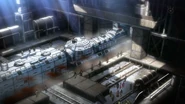Tags: Visual edit apiedit |
(Added trivia about the possible basis of the Iron Fortress. It's a bit of a stretch, the other armored train has a much cleared basis in reality.) Tag: Visual edit |
||
| Line 34: | Line 34: | ||
The locomotive recently acquired a new cannon after its successful passage of the [[Yashiro Station]]. |
The locomotive recently acquired a new cannon after its successful passage of the [[Yashiro Station]]. |
||
| − | The locomotive is capable of running at |
+ | The locomotive is capable of running at high speeds (based on episode 1 the train seemed to move at about 90-100 Miles per hour) since its engines have high output due to efficient vapor compression. |
The Koutetsujou is also an effective mower of kabanes that stand on the rail tracks due to what appears to be a razorlike plow at its front. |
The Koutetsujou is also an effective mower of kabanes that stand on the rail tracks due to what appears to be a razorlike plow at its front. |
||
==Trivia== |
==Trivia== |
||
| + | From several shots, it can be ascertained that the locomotive's wheel arrangement is either 2-6-6-4 or 4-6-6-4 (whyte system), with either 2 or 4 unpowered leading wheels, two sets of 6 driving wheels and 4 trailing wheels, which could be powered by via booster device. Due to the long wheelbase of the locomotive, it would likely be articulated (the leading wheels and the front set of driving wheels are allowed to swivel side to side), although this is never shown. It is possible that both sets of driving and trailing wheels are bogies, although this method of articulation was less common on steam locomotives. |
||
| + | |||
| + | In real life, locomotives with 2-6-6-4 wheel arrangements were utilised by several American railroads, most notably the Norfolk and Western Railroad, predominantly in freight service. |
||
| + | |||
| + | In real life, locomotives with the 4-6-6-4 wheel arrangement, commonly referred to as the "Challenger" type, were used by numerous American railroads, most notably the Union Pacific Railroad, mostly in freight service, although the large (69 inch) driving wheels made them suitable for passenger service as well, with UP's Challengers designed to achieve 70 miles per hour. |
||
==Gallery== |
==Gallery== |
||
Revision as of 20:08, 8 March 2020
The Koutetsujou (甲鉄城, lit. Iron Fortress) is a Hayajiro from Aragane Station. After crossing through Hayatani Station and stopping at Aragane Station, it was used to evacuate Aragane's survivors once the station was breached and overrun by Kabane.
History
The koutetsujou was first seen being attacked by kabanes, presumably going to Aragane Station.
Aragane Station Arc
The Koutetsujou was being maintained by Ikoma and his friend Takumi when they found a kabane heart, which Ikoma took as a sample for his research.
Known Passengers
Design
The Koutetsujou looks almost like a steam locomotive. It is made almost entirely of heavy metal components and it has numerous ports and slits found along its body to allow the internal Bushi to repel any kabanes that have latched on outside. A master key is required to operate the Koutetsujou, which can be inserted in a keyhole in the crew compartment.
The locomotive recently acquired a new cannon after its successful passage of the Yashiro Station.
The locomotive is capable of running at high speeds (based on episode 1 the train seemed to move at about 90-100 Miles per hour) since its engines have high output due to efficient vapor compression.
The Koutetsujou is also an effective mower of kabanes that stand on the rail tracks due to what appears to be a razorlike plow at its front.
Trivia
From several shots, it can be ascertained that the locomotive's wheel arrangement is either 2-6-6-4 or 4-6-6-4 (whyte system), with either 2 or 4 unpowered leading wheels, two sets of 6 driving wheels and 4 trailing wheels, which could be powered by via booster device. Due to the long wheelbase of the locomotive, it would likely be articulated (the leading wheels and the front set of driving wheels are allowed to swivel side to side), although this is never shown. It is possible that both sets of driving and trailing wheels are bogies, although this method of articulation was less common on steam locomotives.
In real life, locomotives with 2-6-6-4 wheel arrangements were utilised by several American railroads, most notably the Norfolk and Western Railroad, predominantly in freight service.
In real life, locomotives with the 4-6-6-4 wheel arrangement, commonly referred to as the "Challenger" type, were used by numerous American railroads, most notably the Union Pacific Railroad, mostly in freight service, although the large (69 inch) driving wheels made them suitable for passenger service as well, with UP's Challengers designed to achieve 70 miles per hour.

